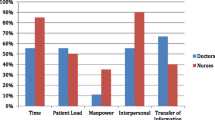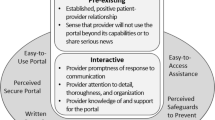Abstract
We describe the patterns and content of nurse to physician verbal conversations in three emergency departments (EDs) with electronic health records. Emergency medicine physicians and nurses were observed for 2 h periods. Researchers used paper notes to document the characteristics (e.g., partners involved, location of communication, who initiated communication) and content of nurse to physician conversations. Eighteen emergency nurses and physicians (nine each) were observed for a total of 36 h. Two hundred and fifty-five unique communication events were recorded across three emergency departments spread evenly across day, evening, and night shifts. A qualitative analysis of communication event content revealed 5 types of communication and 13 content themes. Content themes covered a broad range of topics including exchange of patient health information, management of the ED, and coordination of orders. Physician participants experienced significantly more communication events than nurse participants, while nurses initiated significantly more communication events than physicians. Most of the communication events occurred at the physician workstation followed by patient treatment areas. This study describes nature of verbal nurse to physician communication in the ED. Direct communication is still used to communicate important information, such as information about patients’ status, in EDs with established electronic health records. Our results provide an overview of information exchanged in the ED which can serve as a basis for designing improved information support systems.
Similar content being viewed by others
References
Eisenberg EM, Murphy AG, Sutcliffe K, Wear R, Schenkel S, Perry SJ et al (2005) Communication in emergency medicine: implications for patient safety. Commun Monogr 72(4):390–413
Slade D, Manidis M, McGregor J, Scheeres H, Chandler E, Stein-Parbury J, et al. (2015) The context of communication in emergency departments. In: Communicating in hospital emergency departments. Springer Berlin Heidelberg, p. 25–54
Eisenberg EM (2008) The social construction of health care teams. In: Nemeth C, editor. Improving healthcare team communication: Building on lessons from aviation and aerospace. Ashgate Publishing
Risser DT, Rice MM, Salisbury ML, Simon R, Jay GD, Berns SD (1999) The potential for improved teamwork to reduce medical errors in the emergency department. Ann Emerg Med 34(3):373–383
Kilner E, Sheppard LA (2010) The role of teamwork and communication in the emergency department: a systematic review. Int Emerg Nurs Elsevier Ltd 18(3):127–137
Fairbanks R, Bisantz AM, Sunm M (2007) Emergency department communication links and patterns. Ann Emerg Med 50(4):396–406
Spencer R, Coiera E, Logan P (2004) Variation in communication loads on clinical staff in the emergency department. Ann Emerg Med 2004/08/28 44(3):268–273
Cameron K, Engel KG, McCarthy DM, Buckley B, Mercer Kollar LM, Donlan SM et al (2010) Examining emergency department communication through a staff-based participatory research method: identifying barriers and solutions to meaningful change. Ann Emerg Med Elsevier Inc 56(6):614–622
Redfern E, Brown R, Vincent CA (2009) Identifying vulnerabilities in communication in the emergency department. Emerg Med J 26(9):653–657
Varjoshani NJ, Hosseini MA, Khankeh HR, Ahmadi F (2015) Tumultuous atmosphere (physical, mental), the main barrier to emergency department inter-professional communication. Glob J Health Sci 7(1):144–153
Bagnasco A, Tubino B, Piccotti E, Rosa F, Aleo G, Di Pietro P et al (2013) Identifying and correcting communication failures among health professionals working in the emergency department. Int Emerg Nurs Elsevier Ltd 21(3):168–172
Nemeth CP (2012) Improving healthcare team communication: building on lessons from aviation and aerospace.
Patterson ES, Cook RI, Woods DD, Render ML (2004) Examining the complexity behind a medication error: generic patterns in communication. IEEE Trans Syst Man, Cybern—Part A Syst Humans 34(6):749–756
Woloshynowych M, Davis R, Brown R, Vincent C (2007) Communication patterns in a UK emergency department. Ann Emerg Med 50(4):407–413
Coiera EW, Jayasuriya RA, Hardy J, Bannan A, Thorpe ME (2002) Communication loads on clinical staff in the emergency department. Med J Aust 176(9):415–418
Patterson PD, Pfeiffer AJ, Weaver MD, Krackhardt D, Arnold RM, Yealy DM et al (2013) Network analysis of team communication in a busy emergency department. BMC Health Serv Res 13(109)
Horwitz LI, Krumholz HM, Green ML, Huot SJ (2006) Transfers of patient care between house staff on internal medicine wards: a national survey. Arch Intern Med 166(11):1173–1177
Taylor SP, Ledford R, Palmer V, Abel E (2014) We need to talk: an observational study of the impact of electronic medical record implementation on hospital communication. BMJ Qual Saf 23(7):584–588
Benda NC, Meadors ML, Hettinger AZ, Ratwani RM (2016 Sep 10) Emergency physician task switching increases with the introduction of a commercial electronic health record. Ann Emerg Med 67:741–746
R Development Core Team (2013) R: a language and environment for statistical computing. Vienna, Austria: R Foundation for StatisticalComputing
Klauer KM. 14 tips to improve clinical efficiency in emergency medicine [Internet]. American College of Emergency Physicians Now 2015. Available from: http://www.acepnow.com/article/14-tips-to-improve-clinical-efficiency-in-emergency-medicine/2/?singlepage=1
Searle J (1975) A taxonomy of illocutionary acts. In: Language, mind, and knowledge. Minneapolis, Minnesota
Slade, Diana, Marie Manidis, Jeannette McGregor, Hermine Scheeres, Eloise Chandler, Jane Stein-Parbury, Roger Dunston, Maria Herke and CMM. The context of communication in emergency departments. In: Communicating in hospital emergency departments. Springer Berlin Heidelberg; 2015. p. 25–54
Xiao Y, Schenkel S, Faraj S, Mackenzie CF, Moss J (2007) What whiteboards in a trauma center operating suite can teach us about emergency department communication. Ann Emerg Med 50(4):387–395
Acknowledgements
This work was supported by the Agency for Healthcare Research and Quality (R01HHS022542) (PI: RJF). Ms. Benda is supported by the National Science Foundation’s graduate research fellowship program (1117218). The authors have no conflicts of interest to report.
Author information
Authors and Affiliations
Corresponding author
Ethics declarations
Research approval was obtained from the institutional review board for the healthcare system.
Rights and permissions
About this article
Cite this article
Benda, N.C., Hettinger, A.Z., Bisantz, A.M. et al. Communication in the Electronic Age: an Analysis of Face-to-Face Physician-Nurse Communication in the Emergency Department. J Healthc Inform Res 1, 218–230 (2017). https://doi.org/10.1007/s41666-017-0008-3
Received:
Revised:
Accepted:
Published:
Issue Date:
DOI: https://doi.org/10.1007/s41666-017-0008-3




